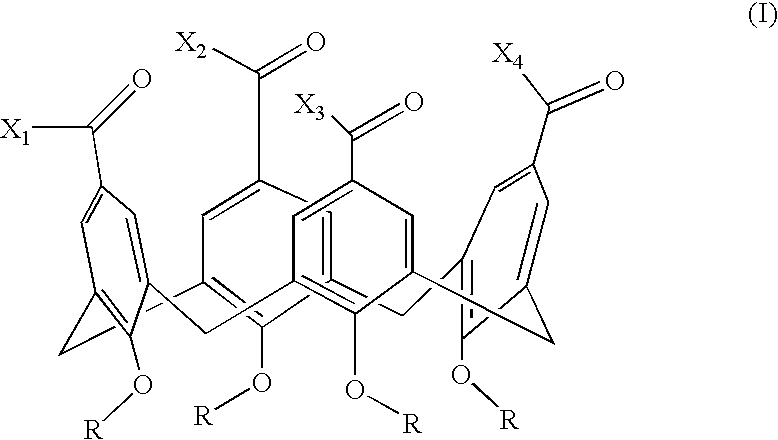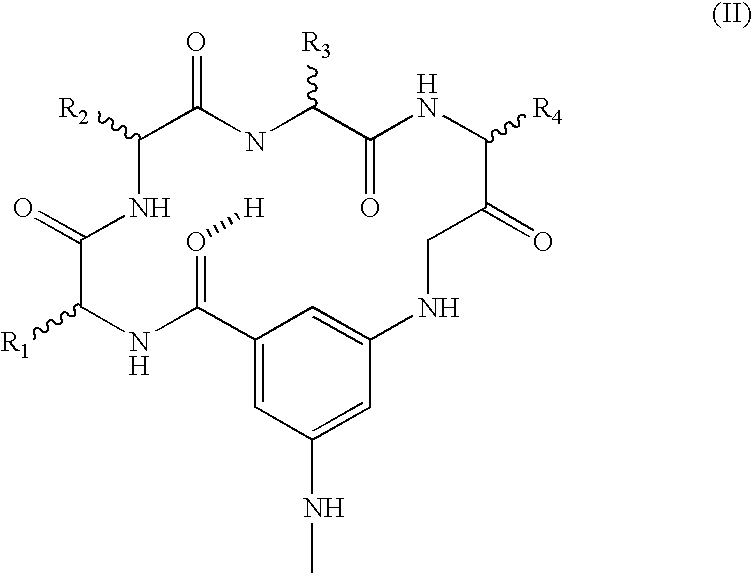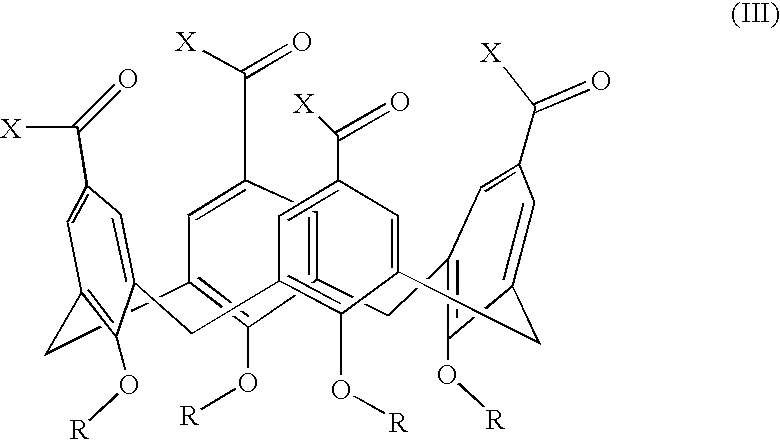Growth factor binding molecules
a technology of growth factor and binding molecules, which is applied in the direction of peptides, angiogenin, drug compositions, etc., can solve the problems of significant morbidity, local damage to the endothelial cell lining of the vessel wall, and no such antibody mimics have been produced that specifically bind growth factors
- Summary
- Abstract
- Description
- Claims
- Application Information
AI Technical Summary
Benefits of technology
Problems solved by technology
Method used
Image
Examples
example 1
PDGF Binding Agents
[0100] 9.2 Design of Molecules that Bind PDGF and Disrupt its Signaling Function
[0101] A novel series of protein surface binding agents are prepared that bind PDGF and disrupt its signaling function. The molecules are composed of a central calix[4] arene scaffold to which is attached four peptide loop domains (FIG. 1). The peptide loop component is based on a cyclic hexapeptide in which two residues are replaced by a 3-aminomethylbenzoate dipeptide mimetic containing a 5-amino substituent for attachment to the scaffold. The resulting molecules (as shown in Table 1) contain a functionalized and variable surface approximately 500 Å2 in area. Several peptide loop sequences are synthesized (Table 1) to provide molecular surfaces with negatively and positively charged as well as hydrophobic regions designed to bind to complementary areas on the target growth factor. To identify PDGF binding molecules from this library, a cell-based screening assay is developed with N...
example 2
VEGF Binding Agents
[0122] 9.10 Inhibition of VEGF-Mediated Tyrosine Phosphorylation and MAP Kinase Activation by GFB-116
s.c. under the flank of nude mice. When the tumors reach an average size of about 150 mm3, the animals are randomized and either treated with vehicle or S3I-124 (1 mg / kg / day) for 10 days. S3I-124 inhibits tumor growth by about 77%.
[0123] This embodiment of the present invention is a compound that binds to VEGF. Furthermore, the invention is directed to a composition for treating a subject, comprising the compound described immediately above, a pharmaceutically acceptable salt of this compound or combination thereof, in a pharmaceutically acceptable carrier.
[0124] A further embodiment of the invention is the administration of this composition to a patient having a condition comprising excess angiogenesis, a tumor or a combination thereof.
TABLE 4AInhibition of VEGF stimulated Flk-1 Tyrosine Phosphorylation and Signaling inFlk-1 / 3T3 by GFBs(IC50) Inhibition (μM...
example 3
aFGF Binding Agents
[0126] 9.11 Inhibition of aFGF Stimulation of p42 / p44 by Growth Factor Binding Agents
[0127] The ability of growth factor binding agents in the library of growth factor binding agents to block an aFGF signal is measured by aFGF-stimulation of MAP kinase activation of p42 and p44 essentially as described above for VEGF. NIH 3T3 cells are used as the target cell. The growth factor binding molecules GFB-106, GFB-116, GFB-126, GFB-127, and GFB-133 are found to be very effective, see Table 5. A preferred embodiment of the invention is a compound that binds to acidic fibroblast growth factor, of the general structure III, in which R is n-butyl, n-propyl, or benzyl, and X1, X2, X3, and X4 optionally comprise covalently attached cyclic peptide loops of the general structure II, wherein R1, R2, R3, and R4 are each amino acid side chains that define a tetrapeptide sequence, wherein said tetrapeptide is covalently attached at the amino and carboxy termini of said tetrapepti...
PUM
| Property | Measurement | Unit |
|---|---|---|
| concentrations | aaaaa | aaaaa |
| concentrations | aaaaa | aaaaa |
| concentrations | aaaaa | aaaaa |
Abstract
Description
Claims
Application Information
 Login to View More
Login to View More - R&D
- Intellectual Property
- Life Sciences
- Materials
- Tech Scout
- Unparalleled Data Quality
- Higher Quality Content
- 60% Fewer Hallucinations
Browse by: Latest US Patents, China's latest patents, Technical Efficacy Thesaurus, Application Domain, Technology Topic, Popular Technical Reports.
© 2025 PatSnap. All rights reserved.Legal|Privacy policy|Modern Slavery Act Transparency Statement|Sitemap|About US| Contact US: help@patsnap.com



